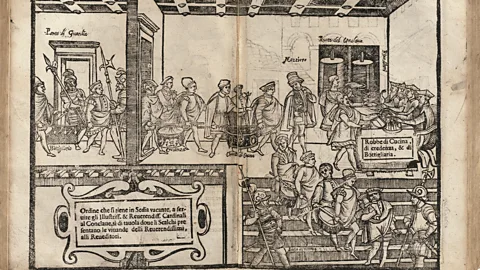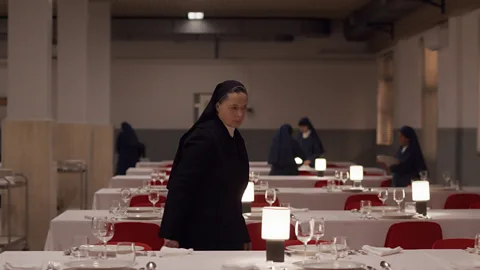Pope Gregory X’s new rules included isolation of the conclave – a rule that is still in effect today – and rationing of the cardinals’ food. After three days without consensus, the cardinals received only one daily meal; after eight days, only bread and water. In the mid-1300s, these rules were relaxed by Clement VI, who permitted three-course meals consisting of soup; a main dish of fish, meat or eggs; and dessert, which could include cheese or fruit. While the rationing didn’t stick, tight control over conclaves remains.
The most detailed historical account of the food culture of papal conclaves comes from Bartolomeo Scappi, who was the Renaissance’s most famous chef (and arguably the world’s first celebrity chef) and served both Popes Pius IV and Pius V. His 1570 book, Opera Dell’Arte del Cucinare (The Art of Cooking) – the first cookbook published by a practicing chef – catapulted him to fame. In it, he reveals the secrets of feeding the conclave that elected Pope Julius III, and the extreme practice of surveillance that remains to this day.
According to Scappi, the cardinals’ daily meals were prepared in a communal kitchen by cooks and sommeliers, just two of the many domestic positions that kept a conclave functioning. He identifies that the kitchen was a space where illicit messages could be shared, and notes that guards were stationed there specifically to prevent this. Therefore, twice a day in an order determined by lottery, stewards would ceremoniously bring the food to the ruota. This “wheel” or turntable, built into the wall, allowed food and drink to be passed to the cardinals in their inner hall. Before being passed through the wall, food and drinks were checked by testers to ensure they were not hiding any illicit messages. Every step was closely watched by Italian and Swiss guards.
 Folger Shakespeare Library
Folger Shakespeare LibraryThe foodstuffs were strictly controlled, with nothing permitted that might obscure a secret message. No closed pies. No whole chickens. Wine and water had to be offered in clear glass, not in opaque vessels. Cloth napkins were opened and carefully inspected.
This arrangement was partly to ensure the complete isolation of the cardinals, and partly to assuage concerns about poisoning. After all, especially during the Renaissance, the papacy was a highly influential political position.
Strict protocol and food restrictions aside, the meals Scappi describes sound bountiful and balanced, including salad, fruit, charcuterie, wine and fresh water. Likewise, he describes comfortable accommodations for the cardinals. Each had their own large cell, decorated with silk and amply furnished with a bed, a table, a clothing rack, two stools, a chamber pot and a lockable jar, among many other items. By Scappi’s account, serving in a Renaissance papal conclave wasn’t a bad gig – so long as you didn’t mind constant surveillance.
For the upcoming conclave starting on 7 May, the nuns at the Domus Sanctae Marthae – the modern residence where cardinals live during their sequestration – will prepare simple dishes characteristic of Lazio, the Italian region surrounding the Vatican, and nearby Abruzzo: minestrone, spaghetti, arrosticini (lamb skewers) and boiled vegetables. While this may seem to differ from Renaissance conclaves where meals were prepared by secular domestics operating under strict protocol and close guard, the result is the same: the process is closely controlled, ensuring no information can get in or out.
 Alamy
AlamyIn the first of several kitchen scenes that appear in Conclave, the film makes a point of showing nuns boiling whole chickens for broth – hardly luxurious fare. But it’s the symbolism that’s important. The modern Catholic church – especially coming out of the leadership of Pope Francis – hopes to communicate a simple, wholesome image. Concerns about the potential for food (whole chickens, specifically) to contain literal secret messages have faded. It’s illicit communication through electronic means, another recurring symbol in the film, that’s the concern now.
So, while the Vatican is being swept for hidden electronic devices in preparation for the upcoming conclave, the cardinals will do their own personal preparations, venturing into Rome to linger over a favourite dish or two, perhaps wondering whether it will be their last supper before becoming pope.